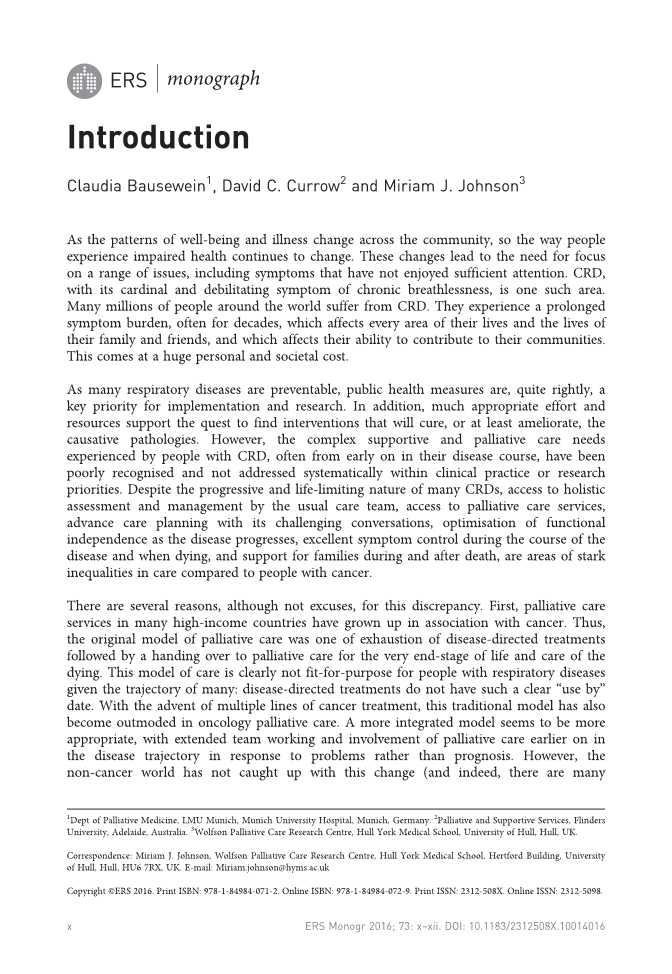ERS | monograph Introduction Claudia Bausewein1, David C. Currow2 and Miriam J. Johnson3 As the patterns of well-being and illness change across the community, so the way people experience impaired health continues to change. These changes lead to the need for focus on a range of issues, including symptoms that have not enjoyed sufficient attention. CRD, with its cardinal and debilitating symptom of chronic breathlessness, is one such area. Many millions of people around the world suffer from CRD. They experience a prolonged symptom burden, often for decades, which affects every area of their lives and the lives of their family and friends, and which affects their ability to contribute to their communities. This comes at a huge personal and societal cost. As many respiratory diseases are preventable, public health measures are, quite rightly, a key priority for implementation and research. In addition, much appropriate effort and resources support the quest to find interventions that will cure, or at least ameliorate, the causative pathologies. However, the complex supportive and palliative care needs experienced by people with CRD, often from early on in their disease course, have been poorly recognised and not addressed systematically within clinical practice or research priorities. Despite the progressive and life-limiting nature of many CRDs, access to holistic assessment and management by the usual care team, access to palliative care services, advance care planning with its challenging conversations, optimisation of functional independence as the disease progresses, excellent symptom control during the course of the disease and when dying, and support for families during and after death, are areas of stark inequalities in care compared to people with cancer. There are several reasons, although not excuses, for this discrepancy. First, palliative care services in many high-income countries have grown up in association with cancer. Thus, the original model of palliative care was one of exhaustion of disease-directed treatments followed by a handing over to palliative care for the very end-stage of life and care of the dying. This model of care is clearly not fit-for-purpose for people with respiratory diseases given the trajectory of many: disease-directed treatments do not have such a clear “use by” date. With the advent of multiple lines of cancer treatment, this traditional model has also become outmoded in oncology palliative care. A more integrated model seems to be more appropriate, with extended team working and involvement of palliative care earlier on in the disease trajectory in response to problems rather than prognosis. However, the non-cancer world has not caught up with this change (and indeed, there are many Copyright ©ERS 2016. Print ISBN: 978-1-84984-071-2. Online ISBN: 978-1-84984-072-9. Print ISSN: 2312-508X. Online ISSN: 2312-5098. Correspondence: Miriam J. Johnson, Wolfson Palliative Care Research Centre, Hull York Medical School, Hertford Building, University of Hull, Hull, HU6 7RX, UK. E-mail: Miriam.johnson@hyms.ac.uk 1 Dept of Palliative Medicine, LMU Munich, Munich University Hospital, Munich, Germany. 2 Palliative and Supportive Services, Flinders University, Adelaide, Australia. 3 Wolfson Palliative Care Research Centre, Hull York Medical School, University of Hull, Hull, UK. x ERS Monogr 2016 73: x–xii. DOI: 10.1183/2312508X.10014016
